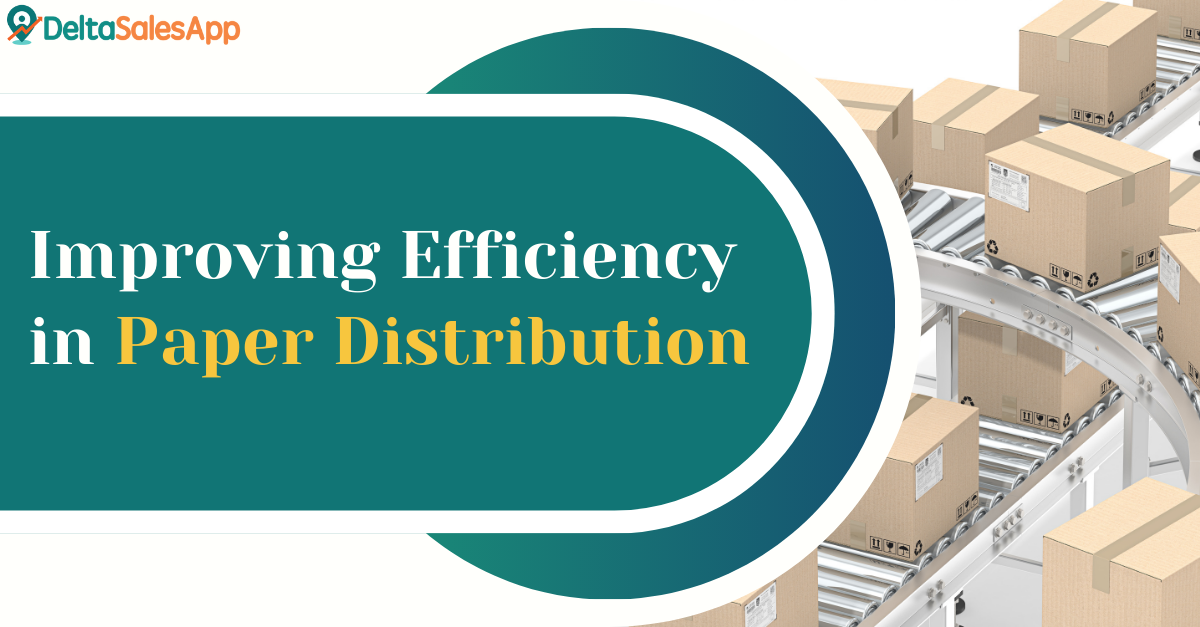Improving Efficiency In Paper Distribution

The paper distribution industry plays a vital role in supplying paper products to businesses, schools, offices, and households worldwide. However, with increasing environmental concerns, rising costs, and the need for faster delivery, improving efficiency in paper distribution has become more critical than ever. From sustainable practices to optimizing supply chains, there are numerous ways to enhance efficiency while reducing environmental impact.
In this blog, we’ll explore strategies to improve efficiency in paper distribution, with a special focus on sustainable practices, innovative solutions, and the role of technology like Field Sales Automation (FSA).
Why Efficiency Matters in Paper Distribution
Efficiency in paper distribution is not just about reducing costs—it’s about creating a sustainable and responsive system that meets customer demands while minimizing environmental impact.
Key Benefits of Efficiency:
Cost Savings: Efficient processes reduce operational and transportation costs.
Environmental Benefits: Sustainable practices help conserve resources and reduce waste.
Customer Satisfaction: Faster delivery and reliable service improve customer trust.
Competitive Advantage: Efficient businesses stay ahead in a competitive market.
Challenges in Paper Distribution
The paper distribution industry faces several challenges that impact efficiency:
Environmental Concerns: Deforestation and waste generation are major issues.
Rising Costs: Fluctuating raw material prices and transportation costs affect profitability.
Supply Chain Complexity: Managing logistics for timely delivery can be challenging.
Waste Management: Excessive paper waste in offices and manufacturing processes.
Energy Consumption: High energy usage in transportation and distribution.
Addressing these challenges requires a combination of sustainable practices, technological advancements, and efficient supply chain management.
Strategies for Improving Efficiency in Paper Distribution
Enhancing efficiency in paper distribution involves optimizing logistics, reducing waste, and leveraging technology.
Optimize Transportation and Delivery Routes
Use Route Optimization Software: Plan the most efficient delivery routes to save time and fuel.
Implement Real-Time Tracking: Equip delivery vehicles with GPS tracking systems for real-time monitoring.
Consolidate Shipments: Reduce unnecessary trips by optimizing load capacity.
Improve Inventory Management
Adopt Digital Tools: Use inventory management software to track stock levels and avoid overstocking or stockouts.
Automate Reordering: Set up automated systems to replenish supplies when inventory runs low.
Monitor Demand Trends: Use predictive analytics to manage inventory more effectively.
Reduce Packaging Waste
Use Eco-Friendly Materials: Switch to recyclable or biodegradable packaging.
Optimize Packaging Sizes: Minimize packaging to reduce waste and transportation costs.
Implement Sustainable Sourcing: Work with suppliers that use sustainable packaging solutions.
Leverage Technology for Streamlined Operations
Adopt Field Sales Automation (FSA): Use FSA tools to manage orders, track deliveries, and communicate with customers in real time.
Utilize Data Analytics: Analyze operational data to identify inefficiencies and optimize performance.
Implement Digital Documentation: Reduce paper usage by transitioning to electronic invoices and records.
Promote Sustainable Practices
Encourage Recycling: Partner with customers to recycle paper waste.
Reduce Office Waste: Promote digital documentation and double-sided printing.
Support Responsible Sourcing: Partner with suppliers that adhere to sustainable forestry practices.
Enhance Collaboration with Stakeholders
Build Strong Partnerships: Work closely with suppliers, manufacturers, and customers to streamline processes.
Promote Transparency: Share progress and performance metrics with stakeholders to build trust.
Encourage Green Initiatives: Collaborate with industry peers to adopt sustainable distribution practices.
Invest in Workforce Training
Train Employees on Technology: Equip your team with the skills to use FSA tools and other technologies effectively.
Promote Safety Protocols: Provide regular training on safety measures to reduce accidents and delays.
Encourage a Culture of Innovation: Empower employees to suggest process improvements and efficiency strategies.
The Role of Field Sales Automation (FSA) in Paper Distribution
Technology, particularly Field Sales Automation (FSA), is revolutionizing the way paper distribution operates.
Streamlined Order Management
Sales teams can place orders directly from the field using mobile apps, reducing delays and errors.
Real-time updates ensure accurate order processing and faster fulfillment.
Optimized Delivery Routes
FSA tools use advanced algorithms to plan the most efficient delivery routes, saving time and fuel.
Real-time tracking ensures timely deliveries and improves customer satisfaction.
Real-Time Inventory Tracking
Distributors can monitor inventory levels in real time, preventing stockouts and overstocking.
Automated alerts notify teams when it’s time to replenish supplies.
Enhanced Customer Relationships
Sales reps have access to customer data, order history, and preferences, enabling personalized service.
Faster response times and accurate order fulfillment build trust and loyalty.
Simplified Compliance and Reporting
FSA automates documentation and reporting, ensuring compliance with industry regulations.
Digital records reduce the risk of errors and make audits easier to manage.
Data-Driven Decision Making
FSA provides actionable insights through advanced analytics and reporting.
Distributors can identify trends, forecast demand, and make informed decisions to improve operations.
Conclusion: Building a Sustainable and Efficient Paper Distribution System
Improving efficiency in paper distribution requires a holistic approach that combines sustainable practices, advanced technology, and optimized supply chain management. By adopting strategies like optimizing delivery routes, leveraging FSA tools, and promoting recycling, paper distributors can reduce costs, minimize environmental impact, and meet customer demands effectively.
The future of paper distribution lies in sustainability and innovation. By embracing these strategies, businesses can stay competitive while contributing to a greener planet.
Frequently Asked Questions (FAQs)
Q1. How can technology improve efficiency in paper distribution?
Technology enhances efficiency by automating inventory management, optimizing delivery routes, and enabling real-time tracking through Field Sales Automation (FSA). These tools reduce manual work, improve accuracy, and speed up order fulfillment.
Q2. What is Field Sales Automation (FSA), and how does it help?
FSA is a digital solution that helps sales teams manage orders, track deliveries, and communicate with customers in real time. It streamlines operations, reduces errors, and enhances customer service.
Q3. What are the key benefits of optimizing delivery routes?
Optimized delivery routes reduce fuel consumption, minimize delivery times, lower costs, and enhance customer satisfaction by ensuring timely deliveries.
Q4. How can paper distributors reduce packaging waste?
Distributors can switch to recyclable or biodegradable packaging, minimize packaging sizes, and work with suppliers that follow sustainable sourcing practices.
Q5. Why is inventory management important in paper distribution?
Effective inventory management prevents stockouts and overstocking, reduces waste, and ensures timely order fulfillment, leading to cost savings and improved efficiency.
Q6. How can businesses make their paper distribution more sustainable?
Businesses can promote recycling, reduce paper waste, optimize logistics, use digital documentation, and partner with eco-friendly suppliers to reduce their environmental impact.
Q7. What role does data analytics play in improving paper distribution?
Data analytics provides insights into demand trends, identifies inefficiencies, and helps distributors make data-driven decisions to optimize operations and reduce costs.









